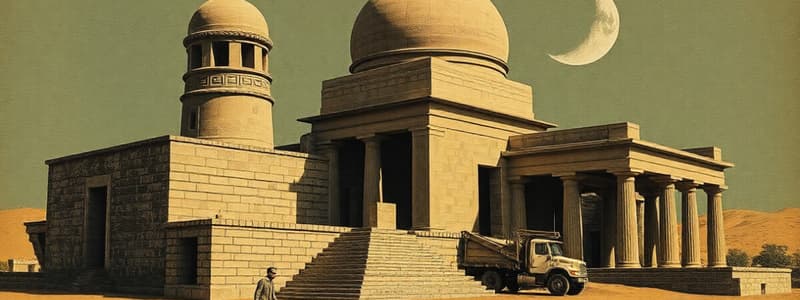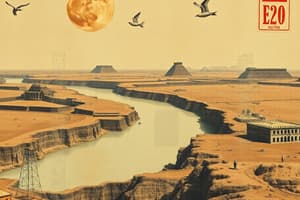Podcast
Questions and Answers
What does the term Mesopotamia mean?
What does the term Mesopotamia mean?
- The land of fertile fields
- The land between two rivers (correct)
- The valley of the Nile
- The land of ancient empires
Which region is considered the heart of the Mesopotamian civilization?
Which region is considered the heart of the Mesopotamian civilization?
- Sumer (correct)
- Babylonia
- Assyria
- Akkad
Which of the following was built around 575 BCE in Babylon?
Which of the following was built around 575 BCE in Babylon?
- The Hanging Gardens
- The Ishtar Gate (correct)
- The Ziggurat of Ur
- The Pyramids of Giza
What was the primary form of governance in Mesopotamia?
What was the primary form of governance in Mesopotamia?
What structure was commonly found in the sacred part of the city?
What structure was commonly found in the sacred part of the city?
Who conquered the Mesopotamian civilization in 539 BCE?
Who conquered the Mesopotamian civilization in 539 BCE?
What was the main threat to the city-states of Mesopotamia?
What was the main threat to the city-states of Mesopotamia?
What term describes the series of small states controlled by individual cities in Mesopotamia?
What term describes the series of small states controlled by individual cities in Mesopotamia?
What material was primarily used for early Mesopotamian buildings before bricks?
What material was primarily used for early Mesopotamian buildings before bricks?
Who had the highest social status in Mesopotamian society?
Who had the highest social status in Mesopotamian society?
What role did the king of Mesopotamia NOT have?
What role did the king of Mesopotamia NOT have?
What was the mainstay of the Mesopotamian economy?
What was the mainstay of the Mesopotamian economy?
What technological advancement aided Mesopotamian agriculture?
What technological advancement aided Mesopotamian agriculture?
What was NOT a product traded by Mesopotamian merchants?
What was NOT a product traded by Mesopotamian merchants?
Which class was NOT part of the Mesopotamian social hierarchy?
Which class was NOT part of the Mesopotamian social hierarchy?
Which was a key feature of Mesopotamian city planning?
Which was a key feature of Mesopotamian city planning?
What type of irrigation system did the Mesopotamians employ?
What type of irrigation system did the Mesopotamians employ?
Which item was historically brought back from India by Mesopotamian traders?
Which item was historically brought back from India by Mesopotamian traders?
Flashcards
Mesopotamia
Mesopotamia
Located between the Tigris and Euphrates rivers, this fertile region played a key role in the development of early civilizations.
Fertile Crescent
Fertile Crescent
A crescent-shaped region in the Middle East, known for fertile land that supported the rise of ancient civilizations.
Sumerians
Sumerians
The earliest inhabitants of Mesopotamia, known for their advancements in writing, mathematics, and city planning.
City-states
City-states
Signup and view all the flashcards
Ziggurats
Ziggurats
Signup and view all the flashcards
King
King
Signup and view all the flashcards
Priests
Priests
Signup and view all the flashcards
Middle class
Middle class
Signup and view all the flashcards
Slaves and peasants
Slaves and peasants
Signup and view all the flashcards
Military
Military
Signup and view all the flashcards
Non-hereditary kingship
Non-hereditary kingship
Signup and view all the flashcards
Kingship responsibilities
Kingship responsibilities
Signup and view all the flashcards
Agriculture
Agriculture
Signup and view all the flashcards
Irrigation
Irrigation
Signup and view all the flashcards
Trade networks
Trade networks
Signup and view all the flashcards
Mesopotamian seals in the Indus Valley
Mesopotamian seals in the Indus Valley
Signup and view all the flashcards
Trade
Trade
Signup and view all the flashcards
Ox-drawn plough and wheeled carts
Ox-drawn plough and wheeled carts
Signup and view all the flashcards
Study Notes
Geography and Early Civilization
- Mesopotamia means "the land between two rivers," located between the Tigris and Euphrates rivers.
- This fertile region, bound by the Arabian Desert to the west and Iranian mountains to the east, is crucial for agriculture.
- Known as the "Civilization of the Crescent," it flourished along the fertile crescent extending from the Persian Gulf to the Mediterranean Sea.
- Major periods of civilization began around 3500 BCE and lasted until about 500 BCE, primarily ruled by the Sumerians.
City-States of Mesopotamia
- Mesopotamia consisted of city-states, each functioning as an independent region with its own capital.
- Key cities included Babylon, Uruk, Eridu, Lagash, and Ur, often engaged in battles for power and resources.
- City-states were characterized by ziggurats (temple towers) made of sun-baked bricks, serving as religious and administrative centers.
- Urban planning was limited; cities developed from original villages, resulting in narrow, rubbish-strewn streets and simple residences.
Social Structure
- Mesopotamian society was hierarchical, with the king at the top, seen as a representative of the divine.
- Priests were the second most powerful group, often serving as initial rulers of cities.
- A middle class comprised merchants, landowners, and craftsmen, while slaves and peasants constituted the lower class.
- The military played a crucial role in society, with all free citizens expected to serve.
Governance and Kingship
- Priest-kings ruled without absolute power, and kingship was not necessarily hereditary.
- The king's responsibilities included defense, infrastructure development (canals and roads), irrigation management, and justice administration.
Economic Activities
- Agriculture was fundamental, with key crops including wheat, barley, and various fruits and vegetables.
- The region employed an advanced irrigation system due to low rainfall, involving navigable canals for transportation.
- The ox-drawn plough and wheeled carts significantly enhanced agricultural productivity.
Trade Networks
- Mesopotamian merchants engaged in extensive trade, encountering foreign regions via land and sea routes.
- Trade included the exchange of grain, wool, and textiles for materials like copper, lead, and precious metals.
- Trade links extended to the Indus Valley, evidenced by Mesopotamian seals found at archaeological sites, indicating a thriving commerce between these civilizations.
Studying That Suits You
Use AI to generate personalized quizzes and flashcards to suit your learning preferences.




